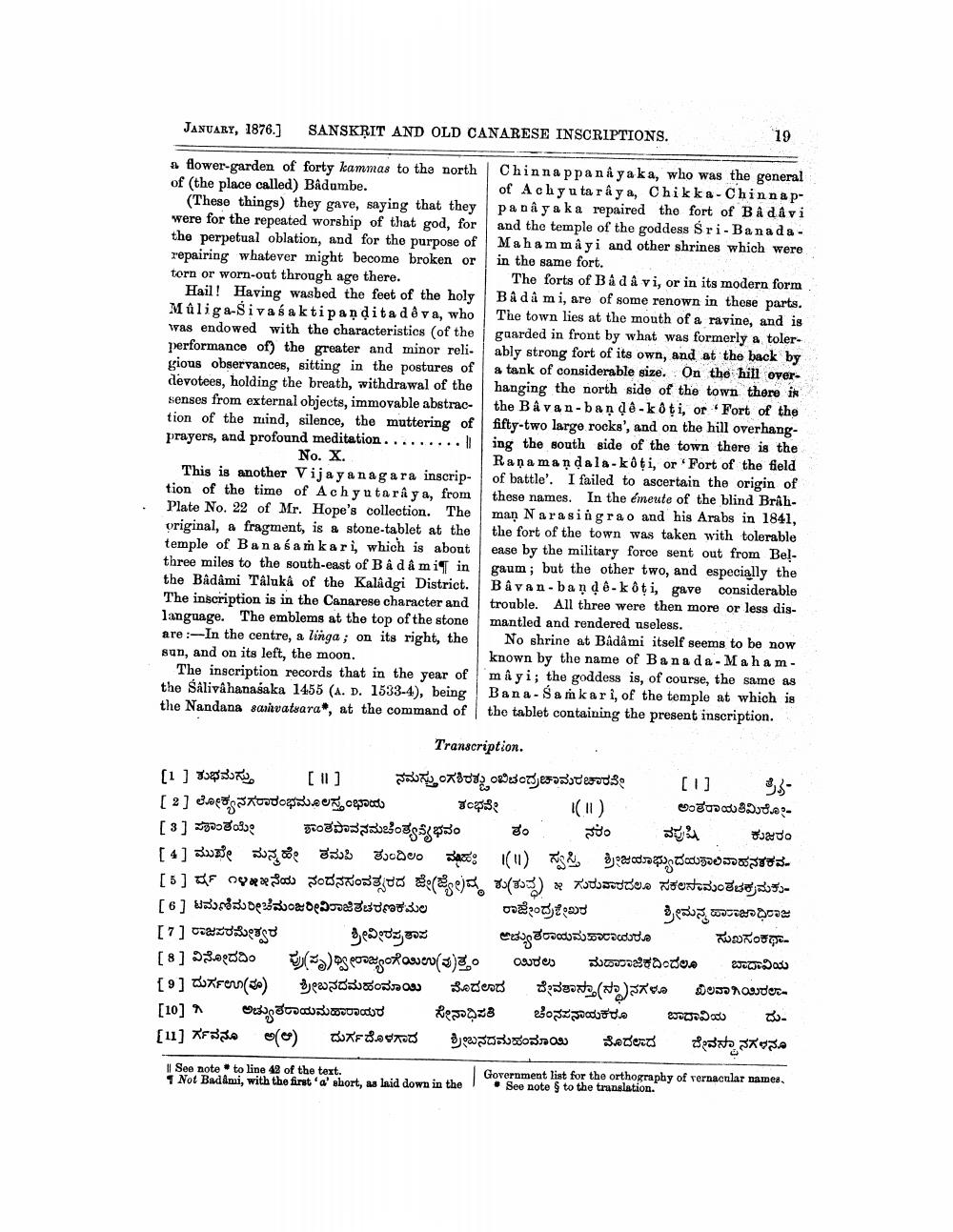________________
JANUARY, 1876.]
a flower-garden of forty kammas to the north of (the place called) Bâdumbe.
SANSKRIT AND OLD CANARESE INSCRIPTIONS.
(These things) they gave, saying that they were for the repeated worship of that god, for the perpetual oblation, and for the purpose of repairing whatever might become broken or torn or worn-out through age there.
Hail! Having washed the feet of the holy Muliga-Sivasaktipandita dê va, who was endowed with the characteristics (of the performance of the greater and minor religious observances, sitting in the postures of devotees, holding the breath, withdrawal of the senses from external objects, immovable abstraction of the mind, silence, the muttering of prayers, and profound meditation....... No. X.
This is another Vijayanagara inscription of the time of Achyutaraya, from Plate No. 22 of Mr. Hope's collection. The original, a fragment, is a stone-tablet at the temple of Bana sam kari, which is about three miles to the south-east of B à dâmi¶ in the Bâdâmi Taluka of the Kalâdgi District. The inscription is in the Canarese character and language. The emblems at the top of the stone are-In the centre, a linga; on its right, the sun, and on its left, the moon.
The inscription records that in the year of the Sâlivahanasaka 1455 (A. D. 1533-4), being the Nandana samvatsara, at the command of
ಅದ್ಯತಾಯನುಹಾರಾಯರ
~(~) as cores of over() ಬನದ ಹಂದ
ದುರ್ಗದೊಳಗಾದ
[1 ] ಶುಭಮಸ್ತು [ 1 ] ನಯಸಂಗಶಿರ [2] ಲೋಕರಂಥಾಲಯ [3] ಪಶಾಂತಯೇ ಕಾಂತವಾದನಮಚಿಂತ್ಯವೈಭವಂ ತಂ
[ 4 ] ಸುಖೇ ಮಸ್ಸಜ್ ಕರುಪಿ ತುಲದಿಂ [೨] ಈ ೧೪೫೬ನೆಯ ನಂದಸಂವತ್ಸರದ ನೀ [ 6 ] ಮಣಿ ಮಂಜರೀವಿರಾತಂಕ ಮಲ [7] ಪರಮೇಶ್ವರ ಶ್ರೀವೀರಪ್ಪ ಕಂದ
[8] ವಿನೋದದಿಂ
[9] ದುರ್ಗಊ(ರ)
[10]
[11] ರ್ಗವನೂ ಅ(ಆ)
Transcription.
ವಹಃ
Chinnappanayaka, who was the general of Achyuta raya, Chikka-Chinnappanâ ya ka repaired the fort of Bà dâvi and the temple of the goddess Sri-BanadaMahammâyi and other shrines which were in the same fort.
The forts of Bà dâ vi, or in its modern form Bâdâ mi, are of some renown in these parts. The town lies at the mouth of a ravine, and is guarded in front by what was formerly a tolerably strong fort of its own, and at the back by a tank of considerable size. On the hill overthe hill hanging the north side of the town there is the Bâvan-bandê-kôti, or Fort of the fifty-two large rocks', and on the hill overhanging the south side of the town there is the Ranamandala-koti, or Fort of the field of battle'. I failed to ascertain the origin of these names. In the émeute of the blind Brâhman Narasingrao and his Arabs in 1841, the fort of the town was taken with tolerable ease by the military force sent out from Belgaum; but the other two, and especially the Bâvan-bandê-kôti, gave considerable trouble. All three were then more or less dismantled and rendered useless.
No shrine at Bâdâmi itself seems to be now known by the name of Banada-Mahammâyi; the goddess is, of course, the same as Bana-Samkari, of the temple at which is the tablet containing the present inscription.
ತಂಭವೆ?
ಸೇನಾಧಿಪತಿ
See note to line 42 of the text.
Not Badami, with the first 'a' short, as laid down in the
ಮೊದಲಾದ
ಪ್ರಚಾರಬಾರ ((11)
19
ನರಂ ಪರ
ಶ್ರೀಬನದಮಹಮಾಯಿ ಮೊದಲಾದ
[1] 36ಅಂತರಾಯತಿಮಿರೋ
1(11) ಸ್ಪ ಸೃಷ್ಟಿ ಶ್ರೀಜಯಾಭ್ಯುದಯಶಾಲಿವಾಹನಶಕವ ಕುಗುದ್ಧ) 8 ಸುಕದ ನಕಸಂಕಟಕ್ರಮಕ
ರಾಜೇಂದ್ರರ ಅಚ್ಯುತರಾಯಮಹಾರಾಯರೂ
ಶ್ರೀಮನ್ಮಹಾರಾಜಾಧಿರಾಜ ಸುಖಸಂಕಥಾ
ಬರಲು ಮಹಾರಾಜಿಕದಿಂದಲೂ ಬಾದಾನಿಯ ಖಿಲವಾಗಿಯಿರಲಾ
ಕೇಳದ ಪ್ರಾಸ) ನನ್ನ
ಚಂನಪನಾಯಕರೂ
ಬಾದಾವಿಯ
ಕುಜರಂ
ದು
ದೇವಸ್ಥಾನಗಳನ
Government list for the orthography of vernacular names. See note § to the translation.




